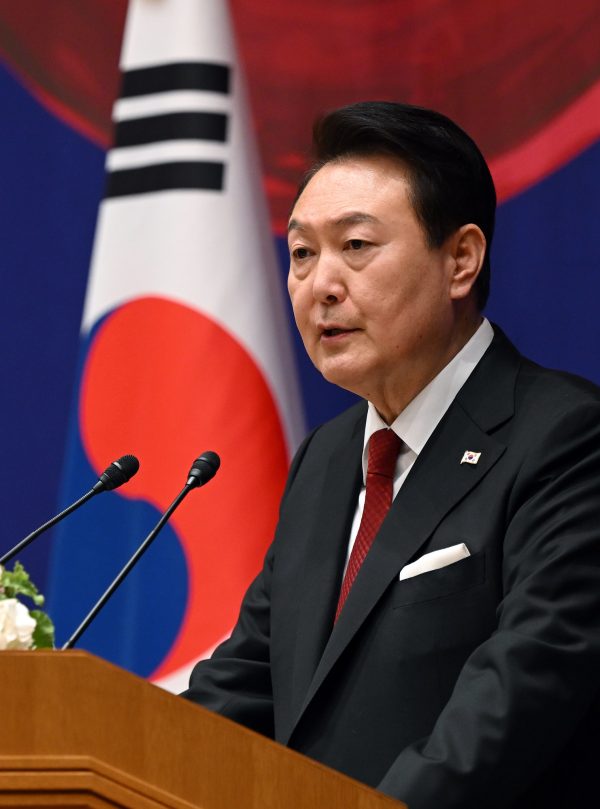
“The path from the ground of South Korea into space has been opened.”
These were the words of South Korea’s President Yoon Suk-yeol on June 30, 2022, after the country launched its first domestically-built rocket, the Nuri (KSLV-II), into orbit, becoming the seventh state in the world to successfully launch a payload greater than one ton. This milestone, Yoon hopes, is the first of many on South Korea’s path to becoming a major space power.
In space, Yoon believes, lies South Korea’s future prosperity. And he’s not wrong. According to McKinsey, the global space industry is set to grow to 1 trillion dollars by 2040, and many nations and businesses are already buying in.
But behind Yoon’s vision lies the real challenge. He needs to solidify programs, institutions, and funds to last beyond his time in office, while he has the power to spearhead such efforts. But simultaneously, Yoon must overcome the capability gap facing South Korea and generate lasting public support.
Shoot for the Moon
In December 2022, the Yoon government released its 4th Basic Plan for Promotion of Space Development that set the following milestones: a moon landing by 2032; a Mars landing by 2045; and the ability for South Korea to make up 10 percent of the global space industry by 2045. The administration also announced the establishment of the Korea Space and Aeronautics Administration (KOSA) by 2023.
Establishing a dedicated space agency is a truly momentous step for South Korea. Creating an agency consolidates the existing research capability of the Korea Aerospace Research Institute with policymaking authorities. By giving such authority to a new, action-oriented organization like KOSA, South Korea will be able to coordinate and mobilize different parts of its government to implement space policy, ensuring that Yoon’s goals will be achieved even beyond his years in office.
Even If You Miss…
However, even with an agency dedicated to space research and policy, the current level of investment may be insufficient to bridge the gap in technology, infrastructure, and institutional knowledge between South Korea and its neighboring space powers — Japan and China — which have decades of experience. One report estimates that it will take over 10 years for South Korea to catch up with the next leading space powers. The scale of the gap also requires an equally massive budget to fill it. Despite Yoon’s ambitious investment plan of $1.2 billion by 2045 — almost double the current investment level — the ROK’s 2022 budget for space is still only one-fifth of Japan’s, whose space program is as aspirational as South Korea’s.
But the biggest sustainer of South Korea’s space development will be public interest. Recently, the ROK Ministry of Science and ICT conducted a survey to gauge people’s opinions on whether KOSA is necessary. Of the 1,000 respondents, 79.6 percent were positive toward the establishment of KOSA, 15.3 percent were neutral, and 5.1 percent were negative. When asked about the most likely setbacks to KOSA, 28.6 percent of respondents answered bureaucratic self-interest, 18.3 percent said the government’s lack of will, 17.1 percent answered the National Assembly’s inability to cooperate, and 11 percent responded cautious established aerospace groups.
Strong leadership, communication, and bureaucratic transparency will be the keys to addressing the concerns of the public. To continue investing in South Korea’s space development, the public must be equally starry-eyed in its vision for South Korea’s future.
…You’ll Land in the Stars
There is undeniable momentum in South Korea’s space sector. South Korea has already made key investments in satellite data, navigation, medicine, energy, and sources associated with space. From 2017 to 2021, the number of jobs in the domestic space industry rose from 6,708 to 7,317. Over 300 private space companies were involved in Nuri’s launch — a number that will only grow with further government investment.
South Korea is also claiming its stake in international space cooperation. In 2019, it became one of 10 signatories of the U.S.-led Artemis program, one of the biggest undertakings of international space cooperation. In the past two years alone, South Korea signed security agreements and Memorandums of Understanding on space cooperation with the United States, Australia, Luxembourg, and the United Arab Emirates.
Yoon must continue to nurture the Korean public’s curiosity and desire for space, imparting a vision that can come to fruition past his time as president. The Yoon administration has charted a strong foundation for South Korea’s domestic space architecture. But now, South Korea must make it a reality.
Making Yoon’s Space Vision a South Korean Reality
Source: Frappler

0 Comments